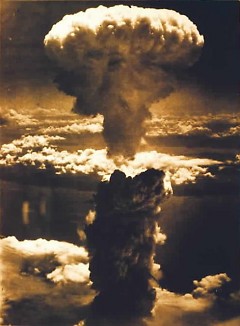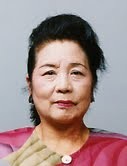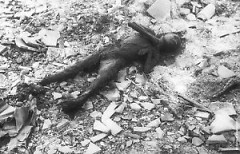HIROSHIMA POSTER DISPLAY OPEN TO PUBLIC THROUGH MARCH 14
There is still time to take advantage of the Hiroshima Poster display at Dominican Center at Marywood. Exhibit Hours: Wednesday and Friday 2 - 6 p.m.; Saturday 10 a.m. - 4 p.m.; and Sunday 12 p.m. - 4 p.m. Also, the Glen Hymer interview will be aired on local television Channels 24 and 25 through March 15. For dates, times and channel, see Rapidian article When Time Stopped.
On Sunday evening (February 28, 2010), Dominican Sisters ~ Grand Rapids Culture of Peace Committee hosted a live Web video interview with Seika Ikeda, a survivor (Hibakusha) of the Aug. 1945 US atomic bombing of Hiroshima, Japan. The video conference is part of a Hiroshima Peace Memorial Museum project that has the goal of global nuclear disarmament. In 2007 and 2008, 14 Japanese atomic bomb survivors toured fifty-three cities in the US. In 2009 and 2010, the survivors have continued the project via video conference.
Streamed live from Hiroshima to an Aquinas College conference room, the interview centered on Ms. Ikeda’s experience in the direct aftermath of the bombing. When the bomb exploded less than a mile away, she was working with a group of 1,500 other middle school students who had been mobilized to help build firebreaks in the city.
"Because we were mobilized students working in the open air, we had fierce exposure,” she said. “Our city was obliterated in a second. Sixty-five years have passed, but for those of us who survived it seems like yesterday. At any time, the radiation in our bodies could take us.”
I knew I was naked but I didn’t care.
Ms. Ikeda recalled seeing a flash “tens of thousands times brighter than lightning,” hearing a tremendous boom and then everything went black. The blast threw her 15 meters through the air and into unconsciousness. When she came to, her hair was singed, her clothes burned off with bits of fabric burned into her skin and her skin was hanging, in tatters, from her body. “I knew I was naked but I didn’t care as I saw my skin hanging, flayed from me. I screamed for help.”
No help came, so Ms. Ikeda joined a procession of survivors who looked like “ghosts and demons” walking along, out of the rubble that was once their city. “Everywhere, people were piled up like so many charred fish. Their burns were so deep you couldn’t tell if they were men or women, children or adults,” she recalled. “There were a huge number of people still alive who lacked the strength to move, they could only whimper. I tried not to step on them.”
“Many bodies, they still had their teeth clinched. Many bodies were without heads. At first I felt sorry, but after so many, I stopped caring. There’s another pile of people. The bomb also robbed us of our humanity.”
As the procession neared the river, adults and children, whether they could swim or not, plunged in to find relief from their burns. Many drowned or died in the water. Still, more entered the water, even though they were surrounded by corpses, bobbing up and down on the waves. The following days, thousands of bobbing corpses came back into the river with each high tide.
As the procession of survivors mounted a hill outside the city, Ms. Ikeda looked at her friends’ faces. “Their skin was melted like candle wax. I thought that must be what I look like. We walked past collapsed houses where people were trapped, calling for help. I was just a girl. I couldn’t do anything. I closed my ears and kept saying, ‘I’m sorry. I’m sorry.’ An old man grabbed my leg, asking for water . . . He reproached me. I shook his hand off my leg and ran away. For the rest of my life, I see that man in my dreams and in my waking as well as hear the voices of those who asked for help.”
When Ms. Ikeda reached the hilltop, she turned and saw that the whole city had collapsed. Then houses started catching fire, like pieces of paper. Within two or three hours, the whole city was ablaze, a sea of fire, four kilometers in diameter. People burned alive in their homes.
Severely injured and in intense pain, Ms. Ikeda crawled down the other side of the hill on her hands and knees, towards a highway. A woman ran out to her with a curtain snatched from a collapsed house. As she wrapped Ms. Ikeda in it, she said, “You poor thing. A high school girl, naked.”
“I didn’t care if I was naked or not,” Ms. Ikeda said. “There were 8,200 junior high school students working. 6,000 died.”
The Hibakusha: lifetimes of pain and fear, courage and witness
Ms. Ikeda made it to a rescue truck, where she had to argue with the soldier to take the surviving girl students as well as the boys. In the hospital, survivors laid head to head, toe to toe, on mats on the floor, waiting their turn for treatment. “Everyone was crying for parents and for water.”
Flies came to feast on their wounds, laying eggs that became maggots under the skin. When it was finally her turn for treatment, Ms. Ikeda endured the excruciating pain of having the burned-in remainders of her clothing extricated from her flesh. Then, finally, she slept. When she awoke, her eyes were swollen shut and she could barely open her mouth. She heard her own father’s voice calling for her and was able to get out a little answer, “Father.” He could only recognize her by her voice. As US planes were still bombing the area, he waited until dark to bring Ms. Ikeda home on a cart.
For several months, she lay in pain and high fever, vomiting and with diarrhea. After so many died, there was finally a doctor available to come treat her wounds. When she had strength to get up and walk, she approached a group of neighborhood children playing outdoors. They ran from her, crying, “Red Demon! Ogre!”
Ms. Ikeda returned to her house in tears and realized all the mirrors had been hidden. She managed to find a small one in the bottom of a drawer. “When I saw my face I was thunderstruck. It was unlike any face I had ever seen. From that day on, there was emotional pain.”
After returning to school eight months later and feeling the sting of others’ stares, she decided on suicide, something that other young female survivors were committing in epidemic proportions. But, on that day, she overheard her father telling a neighbor how he had risked his own life to remain in their home, nursing her night and day, when the rest of the family had left for a safer area. “I was planning on dying with her in that spot,” he said. “And now she has scars all over her body, but I am so glad to have her health back.”
Ms. Ikeda decided to choose the path of life. Fifteen surgeries alleviated some of Ms. Ikeda’s facial scarring. “Though I could never get back the face I was given, I am still alive . . . What hurts most is (remembering) the people I rushed past, who were asking for help, my own classmates. People who I knew but didn’t recognize.”
“I hope you will ask with me ‘Why is it necessary for people to suffer like this in war?’ War makes people crazy. It isn’t just people who suffer, all living creatures, plants, have a right to live. Hiroshima is a plea for respect for all life. . . It is the duty of every person who survived Hiroshima and Nagasaki, to use the rest of the breaths that we are given to us to get rid of these weapons. I believe in all of you. Listen to the cry of the survivors, the Hibakusha, and work to bring peace.”
Take Action
Steven Leeper, chairperson of the Hiroshima Peace Memorial Museum then spoke to current developments in nuclear disarmament. He believes that the time is ripe for a grass roots movement to demand nuclear disarmament. The elite superpowers are, for the first time, considering nuclear disarmament because they fear that nuclear weapons could “fall into the hands of those wanting to bring the system down.” Even so, the US budget for nukes is increasing. “We need to get some people in the streets,” Leeper said.
He hopes thousands will take to New York's streets May 2 , the day before the UN meets there to review the Nuclear Non-Proliferation Treaty . A contingency of Dominican sisters from Grand Rapids intends to be there, but more people are needed. Leeper also asked audience members to pressure their mayors to join Mayors for Peace .
Leeper noted that the nuclear weapons industry’s influence is one reason these weapons continue to be produced. He mentioned Westinghouse, GE, Raytheon, Bechtel and Texas Instruments as being five of the “dirty dozen” nuclear weapon manufacturers—and recommended the book The New Nuclear Danger by Helen Caldecott.
Disclosure: This piece, written by Stelle Slootmaker, has been republished on The Rapidian with GRIID's permission. Originally published by GRIID on March 1, 2010.
The Rapidian, a program of the 501(c)3 nonprofit Community Media Center, relies on the community’s support to help cover the cost of training reporters and publishing content.
We need your help.
If each of our readers and content creators who values this community platform help support its creation and maintenance, The Rapidian can continue to educate and facilitate a conversation around issues for years to come.
Please support The Rapidian and make a contribution today.



